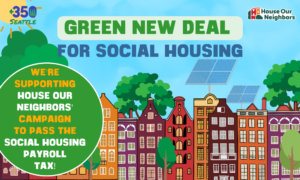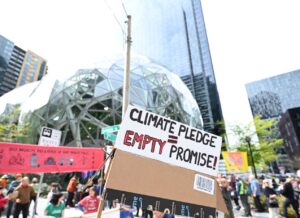Amazon, and Seattle, Are Falling Behind on Climate Action
In 2013, Seattle adopted a Climate Action Plan with a target of carbon neutrality by 2050. A year later, Amazon committed to reaching 100% renewable energy at an unspecified future date. In 2017, shortly after President Trump announced that the US would withdraw from the Paris Climate Accord, both the city and the company renewed their commitments by signing the “We’re Still In” pledge–as did most, if not all, of the cities that will submit a bid for Amazon’s second headquarters (HQ2).
The reality is that Seattle is failing to meet its targets–even though there is now consensus that those targets were inadequately bold. For Amazon, the reality is even worse: it has fallen far behind its peers, and completely lacks transparency; as a result of these facts, and its disproportionate footprint in the city, the company actively hinders the city’s climate progress.
The need for carbon pollution reductions is urgent. This summer, we experienced some of modern history’s most destructive hurricanes, which devastated islands and flooded cities. As of today (October 30), it’s been 40 days since Hurricane Maria, and 70% of Puerto Rico is still without power. Additionally, wildfires have consumed the West Coast in one of the worst fire seasons on record. And around the world, 400,000 people are already dying every year from increased disease, famine, and severe weather due to climate change. All of this is occurring at about 1.2°C above pre-industrial levels; we know that it will get far worse as we reach 1.5° or beyond.
Yet Seattle’s latest climate assessment report found that Seattle has only reduced emissions by 6% from 2008 levels. According to former NASA scientist Jim Hansen, we’ve delayed so long that worldwide, we now need to reduce by at least 10% every year to return to a stable climate. As the Seattle’s largest employer and one of its prime drivers of emissions, shouldn’t Amazon be part of the solution?
Amazon has taken small steps in the right direction, such as eliminating excess packaging, investing in wind energy farms for its data centers, and building green offices (with about a sixth of their buildings being LEED Gold). These practices are highlighted in its HQ2 Request For Proposals (RFP), but the efforts fall far short of the company’s peers, and far short of what science indicates is necessary.
Other tech giants have been aggressively transitioning data centers to clean, renewable energy. Amazon? We don’t know. The company is notoriously secretive, and that extends to its carbon footprint data. The CDP (formerly Carbon Disclosure Project) has given Amazon an F every year for lack of participation in the carbon tracking and reporting standard.
Amazon disavows responsibility for the dirty fuel polluting Seattle (and other regions) from its delivery operations, because most delivery is subcontracted with USPS, Fedex, and UPS–but this is a specious argument, given the company’s potential leverage over these contractors. Additionally, it has started building an Amazon-owned delivery fleet, yet to date it has made no public commitment to eliminate delivery-related pollution. With freight contributing 25% of our city’s transportation emissions (and 16% of its total emissions), we know that if Amazon were aggressively implementing clean-energy vehicles, it would represent meaningful progress towards our climate goals.
At 66% of Seattle’s emissions, transportation is also the area we’ve made the least progress on, with reductions of only 2%–and that progress is solely in passenger transport. Freight transport, which includes all those packages from Amazon, has had a 0% reduction in pollution.
To be clear, this intransigence is not rooted in genuine difficulties in transitioning to zero-emission vehicles–Europe has leapfrogged far ahead of us. In the UK, 100 companies have committed to fully electric fleets by 2020. Germany has made moves to ban internal combustion engines by 2030; Norway, by 2025. Even Los Angeles has moved past Seattle, with its plan to have 100% zero-emission buses by 2030; by contrast, Seattle has promised to only buy emissions-free buses starting in 2025 (without promising to retire the others), and has indicated that it will make some sections of the city emissions-free by 2030.
Amazon has made no commitment to switch to electric vehicles (EVs)–a fact which seems particularly notable because the company has always invested in big, even risky, bets for the future, and EVs are clearly where the market is headed. It has recently become clear that EVs have substantially lower running costs, and are far more durable. The only reason a company with a transportation footprint like Amazon’s could conceivably be postponing its transition, then, is to ensure that other companies are paying the early-adopter premium that it intends to benefit from–a choice that hardly squares with the “we’re still in” rhetoric of a climate-concerned, reality-based company.
Far from leading, then, they’re hampering progress. The bottom line is that Amazon should be piloting EV transport now, starting with Seattle.
HQ1: Putting the Squeeze on Seattle
The city also needs to greatly reduce pollution from passenger transportation, which accounts for a full 50% of Seattle’s carbon pollution. Seattle has been the fastest growing city in the US for the second time this decade. Our traffic has worsened accordingly; we currently have the fourth-worst congestion in the country. Given this traffic, growth, and the urgent need to address the climate crisis, it’s clear that serious investments in mass transit are essential.
Amazon moved into its downtown Seattle headquarters in 2010 and began expanding rapidly. In the seven years since, the price of a Seattle home has increased by 83 percent and rents have increased by 47 percent. While Amazon has created thousands of jobs in Seattle, especially high-wage tech jobs, not all communities share the prosperity.
As the cost of living has risen, public and affordable housing have not been able to keep pace. This is causing a homelessness crisis in Seattle, as well as displacement; people have to move further from the city to find affordable housing. When they do so, their access to transit worsens, and cars and longer commutes become necessary.
It’s no coincidence that between 2010 and 2015, the number of Seattle workers who spend more than 3 hours a day commuting has increased by 72%. Longer commute distances contribute substantially to carbon emissions; they’re also linked to lower quality of life and pollution-related health impacts.
Only investments in city-center and close-in affordable housing and mass transit can dramatically reduce pollution and improve quality of life: imagine a city with safe, clean, and ubiquitous transit around the clock, a city where cars are minimized and the streets are returned to transit, pedestrians, and cyclists. We aim to be a world-class city; this is what world class cities do, particularly as the climate clock ticks. But without a state income tax, Seattle struggles to fund these and other much-needed investments. We have the most regressive tax system in the country, relying on sales tax, car fees, and property taxes, which put a much higher burden on cash-poor communities.
And Amazon? Amazon skirts taxes and claims $61 million in tax breaks from Washington state, while CEO Jeff Bezos donates 100K to fight a state income tax on high earners (a tax championed by Bill Gates, Sr.). The impacts of this miserly and regressive landscape are hard to overstate; Amazon executives clearly seem to feel that because they are employing people, their impacts on housing, transit, and local health are irrelevant, never mind the urgent threats all of these pose to climate stability.
We disagree.
A Note to Cities Competing for HQ2:
While well-paying jobs are certainly desirable, by themselves, they do not make a company a good neighbor. What does? At what point does a company’s size require it to understand and mitigate its impacts? Shouldn’t any company that’s committed to a city act as a partner in addressing the most serious threat facing humanity right now? Shouldn’t it care about local impacts as well, whether pollution-induced asthma from diesel fumes, galloping housing prices, or under-funded schools?
With Amazon HQ1 in our city, we’ve learned that we can’t count on Amazon to be a partner in fighting climate change, despite its rhetoric about being “still in” the Paris agreement. We sincerely hope to work with the HQ2 city to change this, and urge the company to be a real leader.
(For a humorous take on HQ2 risks, check out Love, Little Rock below.)








